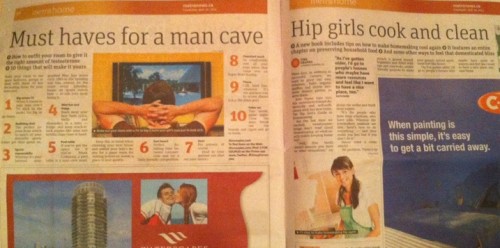Tiffani W. at Peppermint Kiss sent in a great example of the social construction of gender and the devaluation of all things feminine, a comic on why men insist on peeing standing up was posted at The Oatmeal. The uptake:
Women sit down to pee. Women are sissy bitches. Therefore, sitting down to pee makes you a “sissy bitch.” If that second sentence weren’t there, the joke wouldn’t make any sense.
Not only do people think that it is girly (yuck!) to sit down and pee, they also think that it is natural that men stand. However, this is learned behavior. While peeing is biological, where and how we pee are cultural and imbued with meaning.
Whether you sit or stand depends on where you are in the world. I have personally witnessed women standing to pee in Ghana, and they did not make the mess that I, without any practice, would make. Enough Ghanaian women stand to pee for this sign to make sense (link):
Ignoring the fact that some women in other areas of the world stand to pee, many westerners claim–because they assume we are more civilized–that men evolved to stand while women evolved to sit. They think it is natural.
However, it may really be natural to squat. There is speculation that many of the ancient toilets that we assume people sat on were actually squat toilets. We may have actually squatted throughout much of history. If you have ever spent time around small children, you know they instinctually squat before we teach them to sit or stand. Furthermore, the American Academy of Pediatrics recommends teaching a young boy to sit first. When you really, really, really want a young boy to just use the toilet instead of a diaper, the last thing you want to do is make it confusing by trying to teach him that sometimes you sit and sometimes you stand.
But many parents will go to a lot of trouble to teach gender even though it might cause them more trouble and a messy bathroom, hence the existence of tinkle targets and potty-training urinals like the one shown here, which promises to give your son a “real ‘stand up’ experience”:
On the other hand, in line with our greater comfort with women adopting masculine behaviors than men adopting feminine ones, a quick Google search yields a plethora of sites teaching women how to stand while peeing. And if you just can’t master it, well then there is a product for that.
So even something as seemingly “natural” as peeing varies culturally and illustrates our insistence in the U.S. on emphasizing gender difference and placing gender-segregated practices in a hierarchy that values masculine traits over feminine ones — even ones that are as mundane as how we pee.
Christina Barmon is a doctoral student at Georgia State University studying sociology and gerontology.












